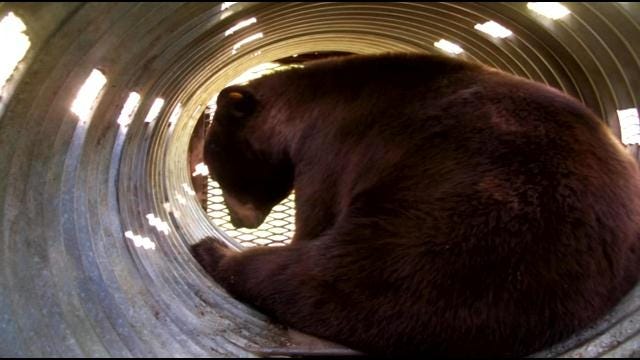Wildlife Expert: Black Bear Population Growing In Eastern Oklahoma
The number of black bears in Oklahoma is growing and wildlife experts think we'll see even more of the animals here in eastern Oklahoma.Thursday, May 9th 2013, 7:03 pm
A young bear captured in a Tahlequah neighborhood near the Northeastern State University campus is now back in the woods. The state wildlife department released the bear in a wildlife area.
The number of black bears in Oklahoma is growing and wildlife experts think we'll see even more of the animals here in eastern Oklahoma.
As a crowd of about 200 people watched, the state wildlife department tranquilized the young bear Wednesday afternoon. He was up in a tree in a Tahlequah neighborhood.
The young male, who weighed 90 pounds, hadn't been on its own for long.
"After a year-and-a-half, she runs off the cubs and they go out looking for new country," said Northeast Region Wildlife Coordinator Craig Endicott.
5/8/2013 Related Story: Baby Bear Causes Stir Near NSU Tahlequah Campus
Endicott said black bear sightings, even in residential areas, are becoming more common.
"We're seeing more of it every year, and would expect to see more in the coming years," Endicott said.
That's mostly because the bear population is growing in Oklahoma.
Arkansas reintroduced bears in the 1960s. Over time, their numbers have improved and they're now moving more often to habitat in Eastern Oklahoma.
"They're just coming back into the habitat that they previously inhabited, and so we see it as a good thing," Endicott said.
The wildlife department, along with the Cooperative Wildlife Research Unit at OSU are in the third year of a study of black bears in Oklahoma. During that time, they've trapped 20 bears.
"We know, seasonally, their movements, we also locate their dens in the winter and then we go back and work those cubs that the females have," Endicott said.
They measure the animals, get DNA samples and some are equipped with GPS tracking devices. Right now, there are eight bears with GPS monitors. The wildlife department and OSU get up to four readings from them each day. The data is valuable to researchers.
"If you're wanting to manage that population, it's really critical to have that information, because there's really no other way to get it. With the technology we have today, to have these satellite transmitter collars, you can find out a lot about these animals," Endicott said.
Just in the past week, the wildlife department recaptured one bear and trapped two others, one of which was a huge 360-pound bear.
The wildlife department's bear trapping season runs through July. They have eight traps in eastern Oklahoma, in Adair, Sequoyah and Cherokee Counties.


Craig Day
Craig Day anchors the 5, 6 & 10 o’clock newscasts at News On 6. He’s an Emmy and national Edward R. Murrow award winner, whose work has also been recognized with awards by several other journalism groups, including the Oklahoma Society of Professional Journalism, Oklahoma Associated Press, and broadcasting associations in Louisiana and Texas, including reporter and story of the year when he worked in Shreveport, Louisiana.
More Like This
January 2nd, 2025
September 29th, 2024
Top Headlines
April 10th, 2025
April 10th, 2025
April 10th, 2025












